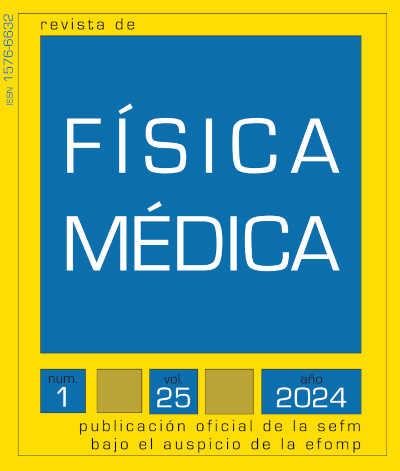Control de calidad para PET/RM basado en maniquíes experimentales con evaluación de factores de degradación por movimiento respiratorio
DOI:
https://doi.org/10.37004/sefm/2024.25.1.004Palabras clave:
PET/RM, control de calidad, maniquíes experimentales, movimiento respiratorio, corrección por atenuaciónResumen
El objetivo de este estudio es crear una prueba de control de calidad (CC) basada en maniquíes experimentales para equipos híbridos PET/RM. Se ha validado un método que minimiza el error en los mapas de atenuación (MA) para medidas de maniquíes con PET/RM, y se ha implementado en el CC para evaluar el impacto de distintos factores de degradación por movimiento respiratorio.
Se empleó el maniquí MRI-QUASAR-Motion con insertos de impresión-3D, así como la herramienta Duetto para generar los MA a partir de tomografías computarizadas (MA-TC). Mediante coeficientes de recuperación (CR), se cuantificó el impacto de la compensación de movimiento en los MA, la discriminación de ciclos irregulares y el promediado para las fases respiratorias co-registradas en imágenes PET. No se observaron mejoras significativas al compensar el movimiento en los MA (p=0.31) ni al discriminar ciclos irregulares (p=0.16). Tampoco se observaron diferencias significativas entre estimar la concentración en cada fase respiratoria y promediar su valor (RCconcentración=0.982±0.013) o estimarlo en la imagen promedio de las fases respiratorias (RCconcentración=0.978±0.009).
Nuestra prueba de CC permite recomendar evitar el postproceso que implica la compensación de movimiento respiratorio en los MA, la discriminación de ciclos respiratorios irregulares y el co-registro de las fases respiratorias.
Referencias
Meikle SR, et al. Quantitative PET in the 2020s: a roadmap. Phys Med Biol. 2021;66(6). https://doi.org/10.1088/1361-6560/abd4f7
Zhu T, Das S, Wong TZ. Integration of PET/MR Hybrid Imaging into Radiation Therapy Treatment. Magn Reson Imaging Clin N Am. 2017; 25(2):377-430. https://doi.org/10.1016/j.mric.2017.01.001
Currie GM, Kamvosoulis P, Bushong S. PET/MRI, Part 2: Technologic Principles. J Nucl Med Technol. 2021; 49(3):217-225. https://doi.org/10.2967/jnmt.120.261862
Balyasnikova S, et al. PET/MR in oncology: an introduction with focus on MR and future perspectives for hybrid imaging. Am J Nucl Med Mol Imaging. 2012; 2(4):458–474.
Lennie E, Tsoumpas C, Sourbron S. Multimodal phantoms for clinical PET/MRI. EJNMMI Physics. 2021; 8(62). https://doi.org/10.1186/s40658-021-00408-0
Akamatsu G, et al. A review of harmonization strategies for quantitative PET. Ann Nucl Med. 2023; 37(2):71-88. https://doi.org/10.1007/s12149-022-01820-x
Ehman EC, et al. PET/MRI: Where might it replace PET/CT? J Magn Reson. 2017; 46(5):1247-1262. https://doi.org/10.1002/jmri.25711
Dutta J, et al. Pulmonary imaging using respiratory motion compensated simultaneous PET/MR. Med Phys. 2015; 42(7):4227-4240. https://doi.org/10.1118/1.4921616
Soret M, Bacharach SL, Buvat I. Partial-Volume Effect in PET Tumor Imaging. J Nucl Med. 2007; 48(6):932–945. https://doi.org/10.2967/jnumed.106.035774
Carles M, et al. Evaluation of PET texture features with heterogeneous phantoms: complementarity and effect of motion and segmentation method. Phys Med Biol. 2017; 62(2):652.
Ionascu D, et al. Internal-external correlation investigations of respiratory induced motion of lung tumors. Med. Phys. 2007; 34(10):3893-3903. https://doi.org/10.1118/1.2779941
Carles M, et al. Significance of the impact of motion compensation on the variability of PET image features. Phys Med Biol. 2018; 63(6):065013. https://doi.org/10.1088/1361-6560/aab180
Mancosu P, et al. 4D-PET data sorting into different number of phases: a NEMA IQ phantom study. J Appl Clin Med Phys. 2009; 10(4):220-231. https://doi.org/10.1120/jacmp.v10i4.2917
Dawood M, et al. Respiratory gating in positron emission tomography: A quantitative comparison of different gating schemes. Med Phys. 2007; 34(7):3067-3076. https://doi.org/10.1118/1.2748104
Kesner AL, et al. Validation of Software Gating: A Practical Technology for Respiratory Motion Correction in PET. Radiology. 2016; 281(1):239-248. https://doi.org/10.1148/radiol.2016152105
Chang G, et al. Joint correction of respiratory motion artifact and partial volume effect in lung/thoracic PET/CT imaging. Med Phys. 2010; 37(12):6221-6232. https://doi.org/10.1118/1.3512780
Frood R, McDermott G, Scarsbrook A. Respiratory-gated PET/CT for pulmonary lesion characterisation-promises and problems. Br J Radiol. 2018; 91(1086):20170640. https://doi.org/10.1259/bjr.20170640
Martinez-Movilla A, et al. Comparison of protocols with respiratory-gated (4D) motion compensation in PET/CT: open-source package for quantification of phantom image quality. EJNMMI Phys. 2022; 9(80). https://doi.org/10.1186/s40658-022-00509-4
Modus Medical Devices. QUASAR MRI Motion Phantom. [Consultado 30 jul 2023]. Disponible en: https://modusqa.com/products/quasar-mri4d-motion-phantom/
Park SJ, et al. Evaluation of the combined effects of target size, respiratory motion and background activity on 3D and 4D PET/CT images. Phys Med Biol. 2008; 53(13):3661–3679.
Carles M, et al. 4D FDG-PET quantification in thoracic anatomical structures for anthropomorphic phantom measurements. IEEE Nucl Sci Symp Medical Imaging Conf. 2014:1-4. https://doi.org/10.1109/NSSMIC.2014.7430816
Grant AM, et al. NEMA NU 2-2012 performance studies for the SiPM-based ToF-PET component of the GE SIGNA PET/MR system. Med Phys. 2016; 43(5):2334-2343. https://doi.org/10.1118/1.4945416
Surti S, et al. Performance of Philips Gemini TF PET/CT Scanner with Special Consideration for Its Time-of-Flight Imaging Capabilities. J Nucl Med. 2007; 48(3):471-480.
Saborido-Moral JD, et al. Free automatic software for the quality assurance of CT metrics reproducibility: calibration, edges and radiomics. Phys Med. 2023; 114:103153. https://doi.org/10.1016/j.ejmp.2023.103153
Ziegler S, et al. NEMA image quality phantom measurements and attenuation correction in integrated PET/MR hybrid imaging. EJNMMI Physics. 2015; 2(18). https://doi.org/10.1186/s40658-015-0122-3
Aide N, et al. EANM/EARL harmonization strategies in PET quantification: from daily practice to multicentre oncological studies. Eur J Nucl Med Mol Imaging. 2017; 44(1):17-31. https://doi.org/10.1007/s00259-017-3740-2
Nyflot MJ. et al. Impact of CT attenuation correction method on quantitative respiratory-correlated (4D) PET/CT imaging. Med Phys. 2015; 42(1):110–120. https://doi.org/10.1118/1.4903282
Cui Y, Bowsher J, Cai J. Impact of moving target on measurement accuracy in 3D and 4D PET imaging—a phantom study. Adv Radiat Oncol. 2017; 2(1):94-100. https://doi.org/10.1016/j.adro.2016.12.002
Pönisch F, et al. Attenuation correction of four dimensional (4D) PET using phase-correlated 4D-computed tomography. Phys Med Biol. 2008; 53(13):N259–N268. https://doi.org/10.1088/0031-9155/53/13/N03
Nagel CC, et al. Phased attenuation correction in respiration correlated computed tomography/positron emitted tomography. Med Phys. 2006; 33(6):1840–1847. https://doi.org/10.1118/1.2198170
Lu Y, et al. Respiratory Motion Compensation for PET/CT with Motion Information Derived from Matched Attenuation-Corrected Gated PET Data. J Nucl Med. 2018; 59(9):1480–1486. https://doi.org/10.2967/jnumed.117.203000
Nii T, et al. Evaluation of Data-Driven Respiration Gating in Continuous Bed Motion in Lung Lesions. J Nucl Med Technol. 2023; 51(1):32-37. https://doi.org/10.2967/jnmt.122.264909








